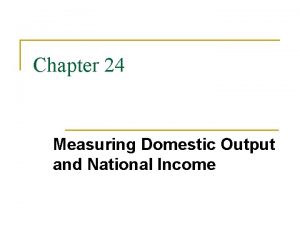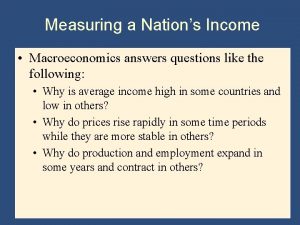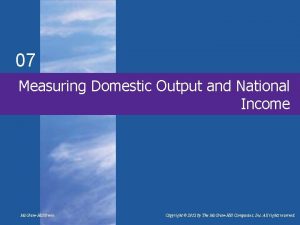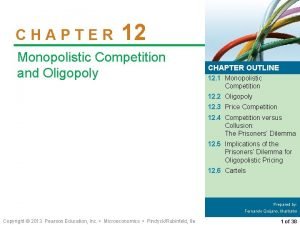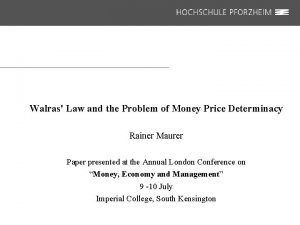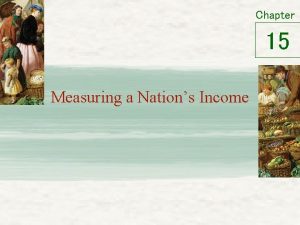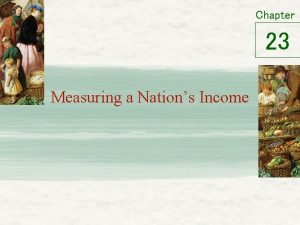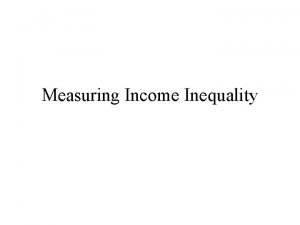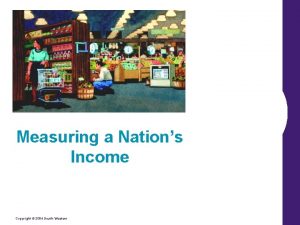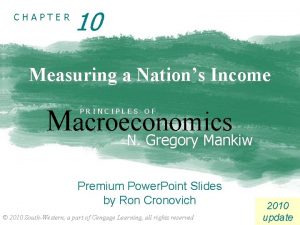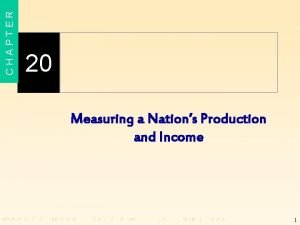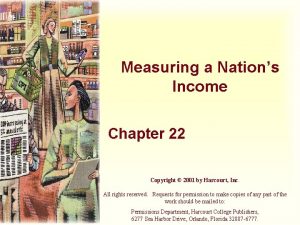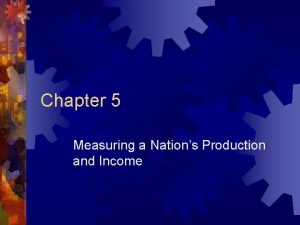Chapter 10 Measuring a Nations Income Microeconomics vs




















- Slides: 20

Chapter 10 Measuring a Nation’s Income

Microeconomics vs. Macroeconomics • Microeconomics – Study of how households and firms • Make decisions • Interact in markets • Macroeconomics – Study of economy-wide phenomena • Including inflation, unemployment, and economic growth 2

The Economy’s Income and Expenditure • Gross Domestic Product (GDP) – Measures the total income of everyone in the economy – Measures the total expenditure on the economy’s output of goods and services • For an economy as a whole – Income must equal expenditure • Circular-flow diagram – assumptions: • All goods and services – bought by households • Households - -spend all of their income 3

Figure 1 The circular-flow diagram Households buy goods and services from firms, and firms use their revenue from sales to pay wages to workers, rent to landowners, and profit to firm owners. GDP equals the total amount spent by households in the market for goods and services. It also equals the total wages, rent, and profit paid by firms in the markets for the factors of production. 4

Measurement of Gross Domestic Product • Gross domestic product (GDP) – Market value of all final goods and services – Produced within a country – In a given period of time • “GDP is the market value…” – Market prices - reflect the value of the goods 5

Measurement of Gross Domestic Product • “… of all…” – All items produced in the economy • And sold legally in markets – Excludes most items • Produced and sold illicitly • Produced and consumed at home • “… final…” – Value of intermediate goods is already included in the prices of the final goods 6

Measurement of Gross Domestic Product • “… goods and services…” – Tangible goods & intangible services • “… produced…” – Goods and services currently produced • “… within a country…” – Goods and services produced domestically, regardless of the nationality of the producer • “… in a given period of time” – A year or a quarter 7

The Components of GDP • Y = C + I + G + NX – Identity – Y = GDP – C = consumption – I = investment – G = government purchases – NX = net exports 8

The Components of GDP • Consumption – Spending by households – On goods and services – Exception: purchases of new housing • Investment – Spending on capital equipment, inventories, and structures – Including household purchases of new housing – Inventory accumulation 9

The Components of GDP • Government purchases – Government consumption expenditure and gross investment – Spending on goods and services – By local, state, and federal governments – Does not include transfer payments 10

The Components of GDP • Net exports = Exports - Imports – Exports • Spending on domestically produced goods by foreigners – Imports • Spending on foreign goods by domestic residents 11

Table 1 GDP and its components Gross domestic product, Y Consumption, C Investment, I Government purchases, G Net exports, NX Total (in billions of dollars) Per person (in dollars) Percent of total $13, 843 9, 732 2, 132 2, 691 – 712 $45, 838 32, 225 7, 061 8, 912 – 2, 360 100% 70 15 19 -5 This table shows total GDP for the U. S. economy in 2007 and the breakdown of GDP among its four components. When reading this table, recall the identity Y = C + I + G + NX. 12

Table 1 Why are we interested on how the GDP changes over time? During last economic recession: 13

Real Versus Nominal GDP • Total spending rises from one year to the next – Economy - producing a larger output of goods and services – And/or goods and services are being sold at higher prices • Nominal GDP – Production of goods and services – Valued at current prices 14

Real Versus Nominal GDP • Real GDP – Production of goods and services – Valued at constant prices – Designate one year as base year – Not affected by changes in prices • For the base year – Nominal GDP = Real GDP 15

Real Versus Nominal GDP 16

Figure 2 Real GDP in the United States This figure shows quarterly data on real GDP for the U. S. economy since 1965. Recessions—periods of falling real GDP—are marked with the shaded vertical bars. 17

GDP - Good Measure of Economic Well-being? • GDP – “single measure of the economic wellbeing of a society” – Economy’s total income – Economy’s total expenditure – Larger GDP • Good life • Better healthcare • Better educational systems – Measure - ability to obtain many of the inputs into a worthwhile life 18

GDP - Good Measure of Economic Well-being? • GDP – not a perfect measure of well-being – Doesn’t include • Leisure • Value of almost all activity that takes place outside markets • Quality of the environment – No distribution of income 19

Table 3 GDP and the quality of life Country United States Japan Germany Russia Mexico Brazil China Indonesia India Pakistan Bangladesh Nigeria Real GDP person (2005) Life expectancy Adult literacy (% of population) Internet usage (% of population) $41, 890 31, 267 29, 461 10, 845 10, 751 8, 402 6, 757 3, 843 3, 452 2, 370 2, 053 1, 128 78 years 82 79 65 76 72 72 70 64 65 63 47 99% 99 99 99 92 89 91 90 61 50 47 69 63 % 67 45 15 18 19 9 7 3 7 0. 3 4 The table shows GDP person and three other measures of the quality of life for twelve major countries. 20
 Measuring domestic output and national income
Measuring domestic output and national income Measuring a nation's income
Measuring a nation's income Measuring domestic output and national income
Measuring domestic output and national income Measuring domestic output and national income
Measuring domestic output and national income Measuring domestic output and national income
Measuring domestic output and national income Calculate real gdp per capita
Calculate real gdp per capita Tax payable
Tax payable Income statement multi step
Income statement multi step Accounting income vs taxable income
Accounting income vs taxable income Microeconomics chapter 12
Microeconomics chapter 12 What is microeconomics
What is microeconomics Micro economics examples
Micro economics examples What is the subject matter of microeconomics
What is the subject matter of microeconomics Limitations of macroeconomics
Limitations of macroeconomics Intermediate microeconomics lecture notes
Intermediate microeconomics lecture notes Intermediate microeconomics notes
Intermediate microeconomics notes Oligopoly model
Oligopoly model Walras law microeconomics
Walras law microeconomics Pure public good
Pure public good Cowell microeconomics
Cowell microeconomics Parkin macroeconomics 13th edition pdf
Parkin macroeconomics 13th edition pdf
